Is Albania Worth Visiting? Exploring the Former “North Korea of Europe”
Disclaimer: Some links on this page may be affiliate links. If you purchase anything through them, I will receive a small commission at no extra cost to you! Further details in the Privacy Policy.
Introduction
Albania was once the hermit state of Europe. However that has changed in the last few decades. In recent years it has exploded in popularity, quickly building a name as an ultra affordable travel destination. It is known for stunning beaches and its fascinating history. Is Albania worth visiting? Read on to find out more.
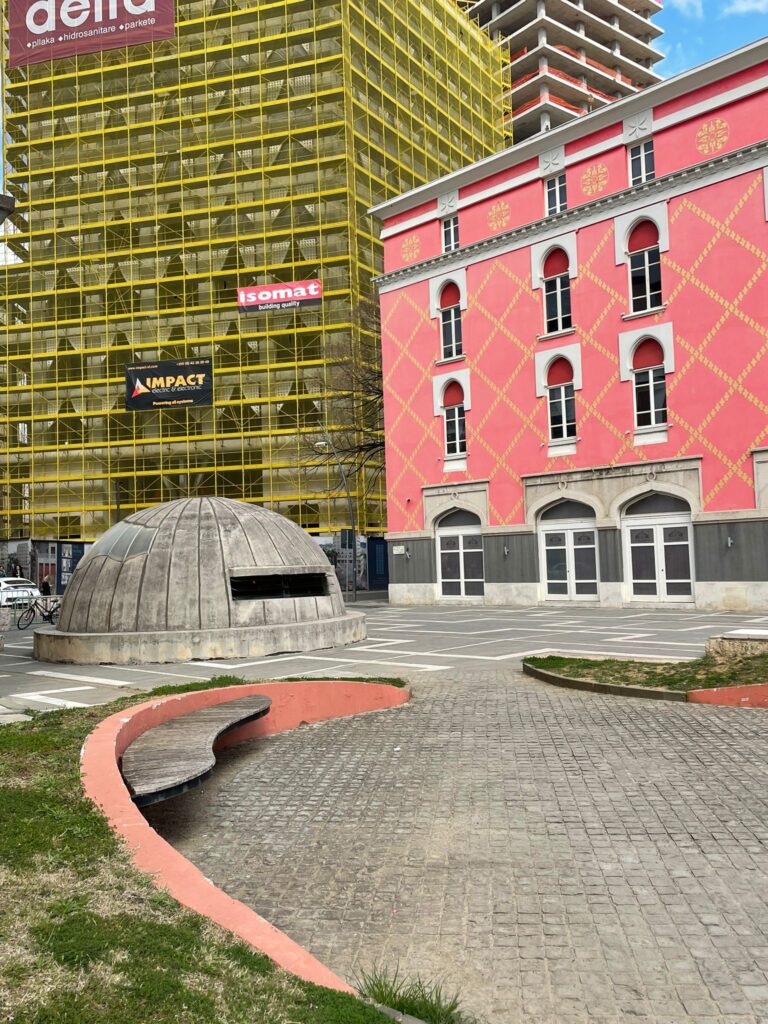
Background on Albania
The Beginning of Communist Rule in Albania
After WWII, communists seized power in Albania. They cracked down on landowners and the middle class, isolated Albania from the west, and executed political rivals as the People’s Republic of Albania was formed.
In 1944, a communist dictator took charge of the country. His name was Enver Hoxha. He would rule Albania right up until his death in 1985.
Communist Albania’s Foreign Relations
Albania’s nearest neighbour was Yugoslavia, another communist state and seemingly a natural ally. Yugoslavia was made up of seven modern-day countries: Slovenia, Croatia, Bosnia Herzegovina, Montenegro, Serbia, Kosovo and North Macedonia.
However there was distrust between Hoxha and Yugoslav leader Tito. Tipped off by Stalin, Hoxha believed Yugoslavia planned to annex Albania. Meanwhile Yugoslavia did not want Albania to conquer Kosovo, a majority ethnic Albanian territory. Hoxha had wanted to create a Greater Albania.
After cutting ties with Yugoslavia, Albania sought closer relations with the Soviet Union. However Khrushchev replaced Stalin as leader, and aimed for peaceful coexistence with the west. Stalinist Hoxha did not like this and relations crumbled here too. Hoxha then chose to become a close ally of Mao’s China. But in 1971, Richard Nixon visited China, and Hoxha saw this as pro-western which he did not like, as a result Albania’s relationship with China also began to sour.
Enver Hoxha’s Legacy, and the End of Communism
Hoxha’s Albania was most notable for keeping the borders firmly shut. No one could enter or leave the country, and anyone attempting to do so would be shot.
Hoxha banned all western products and western media. In fact, when communism collapsed and Albania opened up to the outside world, Albanians would often keep cans of Coca Cola in their bedrooms. This was intended to pay tribute to capitalism and remind them that the dark days were over.
Hoxha had over 173,000 bunkers installed to protect Albania from invasion. Ultimately they were never used for their intended purpose, and many have decayed over the years.
His death in 1985 led to Ramiz Alia taking over. Fearing deadly revolution similar to that in Nicolae Ceausescu’s Romania, Alia opened Albania up to the world allowing travel once more, building closer ties with the west, and enabling the country to transition from communism to democracy.

Is Albania Safe to Visit?
During a free walking tour I did in Tirana, the guide laughed. “Tirana is the safest city in the world right now because we send all our criminals to Western Europe.”
Tirana did indeed have a safe feel to it. The Albanian capital is somewhere you can walk around without having to look over your shoulder constantly. Although you should be wary of pickpockets in Tirana and other tourist spots.
Albania is a country associated with organised crime. The Albanian mafia has heavy involvement in the UK drugs trade. However as a tourist, this should not worry you. These people aren’t interested in tourists and won’t target you unless you’re also involved in nefarious activities which interfere with their operations. And this won’t happen by accident. Please do not be dissuaded from visiting Albania because of issues that won’t affect you.
The risk of natural disasters in Albania is low, but not non-existent. In 2019, 50 people were killed by an earthquake near Durres on the coast. The last major one before that took over 130 lives, although this occurred in 1979. Therefore disasters are not a regular occurrence and shouldn’t impact on your travel plans.
When is the Best Time to Visit Albania?
As with other Balkan countries, the best time to visit Albania is in the shoulder season. This is around April-June time from September-October.
This is because the weather is still warm in these periods. Yet the costs and crowds are not as high as during the July-August peak.
Albania is famous for its beaches these days. As a result, you don’t want to travel here in the winter, as you won’t experience the best the country has to offer. In fact I made the mistake of going too soon (early March) and decided against visiting the beaches. It was simply too cold to justify going.

How to Visit Albania
Fortunately Hoxha is in the history books now, and you can visit Albania without risking a bullet in the back.
Albania’s visa requirements are similar to neighbouring countries. Citizens of pretty much every European country can get in without a visa. Russia is the exception. Likewise, mainland American countries mostly have visa-free access to Albania. The exceptions are Bolivia, Ecuador, Suriname and Belize.
Most other countries require a visa to visit Albania. Notable exceptions include Australia, New Zealand, Malaysia, China, Japan, South Korea and the UAE.
How to get to Albania
There are two international airports in Albania: Tirana and Kukes. A third, Vlora, is currently under construction with a target completion date of April 2024. Vlora is being built to provide easy access to the Albanian Riviera which is rapidly growing in popularity.
Buses run from all neighbouring countries: Montenegro, North Macedonia, Kosovo and Greece. Whilst boats cross from Italy and Greece.
How to get Around Albania
There are no trains in Albania, other than freight trains between Podgorica and Shkoder. Therefore you need to catch a bus to get around the country with ease.
Buses run regularly between pretty much every town and city in the country. Just be sure to arrive early because buses generally leave as soon as they are full.
To drive in Albania you require an international driving permit. Renting a car in Albania can cost as little as 10 euros per day.
Is Albania Cheap to Visit?
Albania is one of the cheapest countries in Europe. This is one of the best places you can possibly visit on a budget. Every expense here is cheap: accommodation, food, transport and more.
I averaged spending £17 ($21) per day here. This made it the joint-cheapest country in Europe which I’ve visited, alongside Moldova. For context I have been to 29 countries in Europe including pretty much all of the cheap ones. Only Czech Republic, Belarus and Russia await which could potentially rival Albania in the affordability stakes. Although I doubt they’ll be able to match it.
Where Should I Spend a Week in Albania?
Is Albania worth visiting? Absolutely. But what should you do if you only have a week in Albania? I only suggest places I have visited. In this case it will be Tirana and Shkoder. Although I will briefly round up other popular places at the end.
Tirana
Tirana is the capital of Albania and the number one spot if you are interested in the country’s history. In fact the best thing you can do in Tirana is a free walking tour. Here you will be able to explore the city with a local expert who will know all the history, show you the best places, and give you a greater understanding of Tirana and Albania in general.
Skanderbeg Square
The free walking tour starts here.
Skanderbeg Square is one of the largest public squares in the Balkans.
After the collapse of communism, angry locals ripped down a statue of Enver Hoxha which once stood here. One statue which does remain is that of Skanderbeg (real name: Gjergj Kastrioti), the Albanian national hero who resisted Ottoman forces.
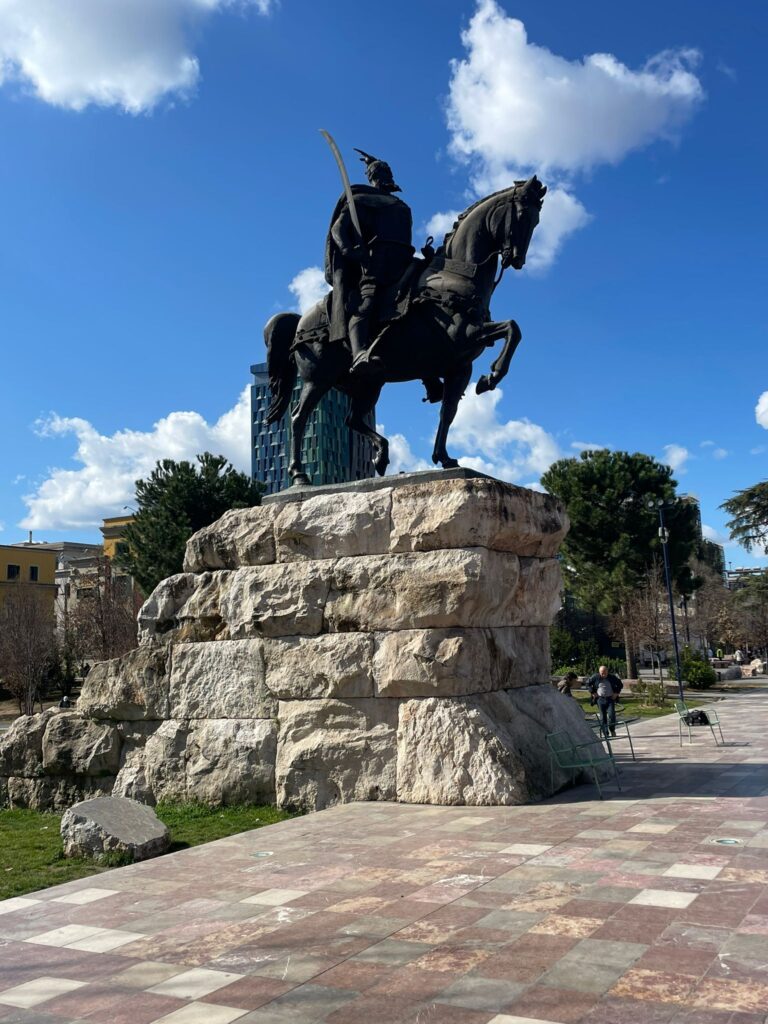
Tirana’s Bunkers
The tour continues towards some of Tirana’s remaining bunkers from the Hoxha era. These concrete shells are buried in the ground, with tiny holes, used as windows to fire weapons from. It would take a pretty good shot to hit anyone within one of the bunkers. Therefore Hoxha installed thousands of them across the country, due to his paranoia about a possible invasion.
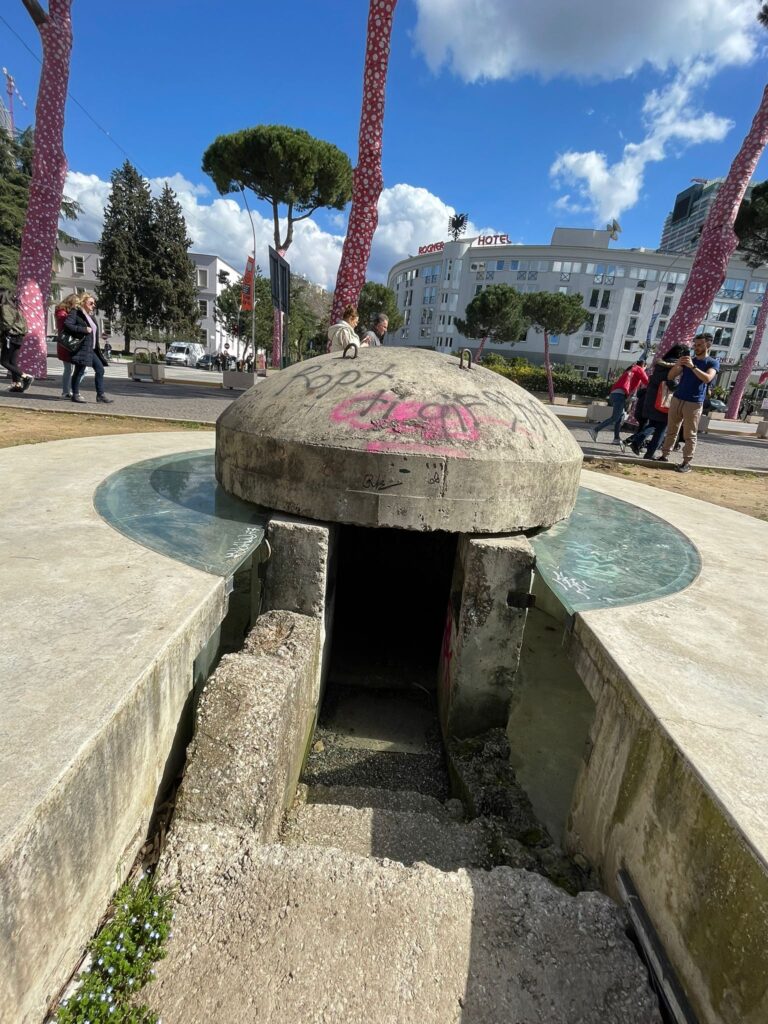
One bunker on the tour is based next to a section of the Berlin Wall, which stands in public as a tribute to all those who suffered under communist rule.
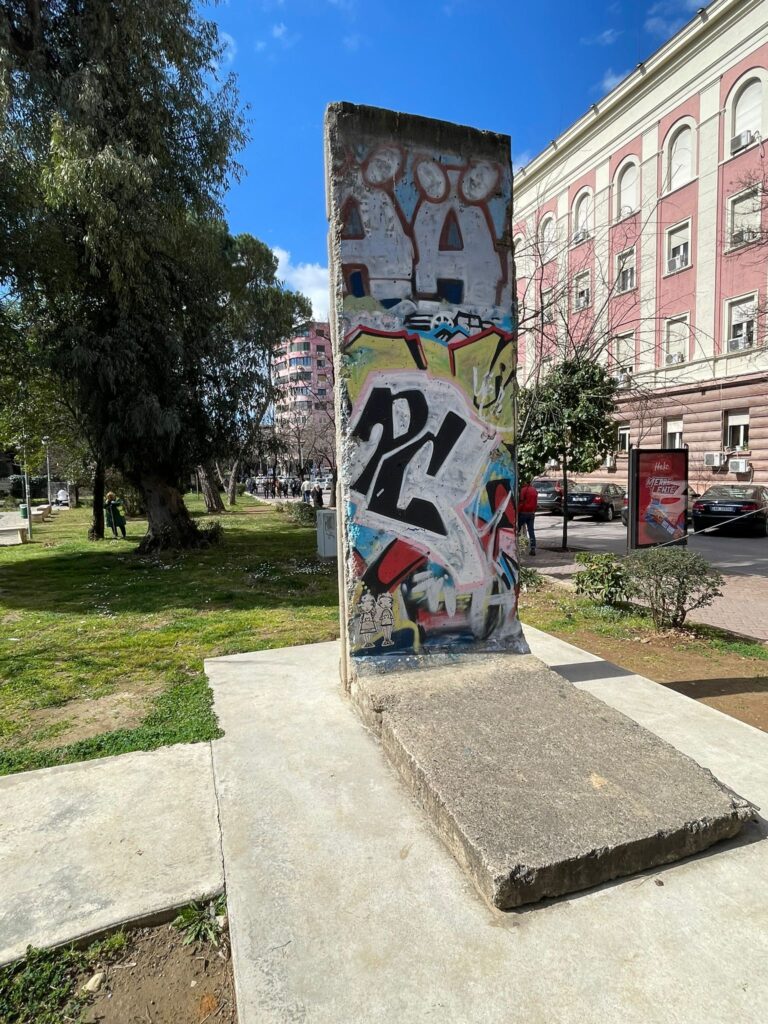
These bunkers are uniquely Albanian. You won’t find them anywhere else in the world.
Enver Hoxha’s Pyramid
Designed by architect Pranvera Hoxha, Enver’s daughter, a pyramid-shaped building was built as a museum paying tribute to him three years after his death.
However, anti-communist and anti-Hoxha sentiment was high. And the pyramid soon became a conference center, with NATO taking it over as a base for humanitarian operations during the Kosovo war in 1999. It has been repurposed several times since as a broadcasting center, film set, youth center, and now it is undergoing renovation once again.
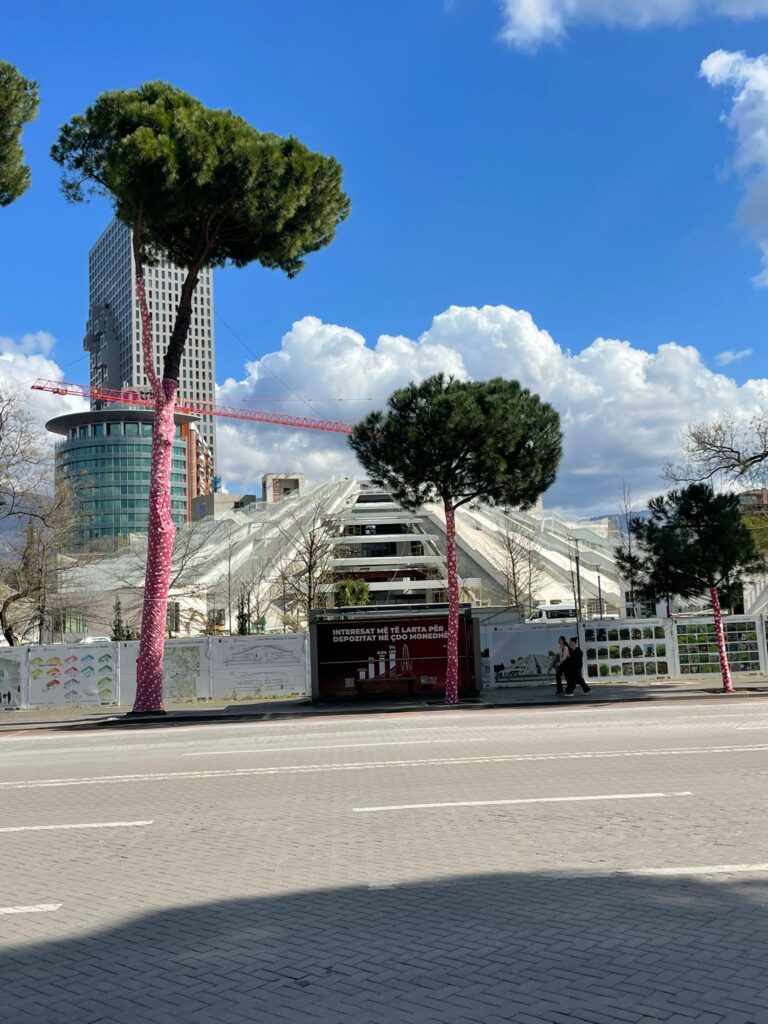
Enver Hoxha’s House
Yes, Tirana’s history and main sites revolve around one man. You can’t avoid this guy when you’re visiting Albania.
His three-story villa remains in Tirana’s Blloku neighbourhood, filled with socialist art, and televisions once used to watch the torture of his opponents.
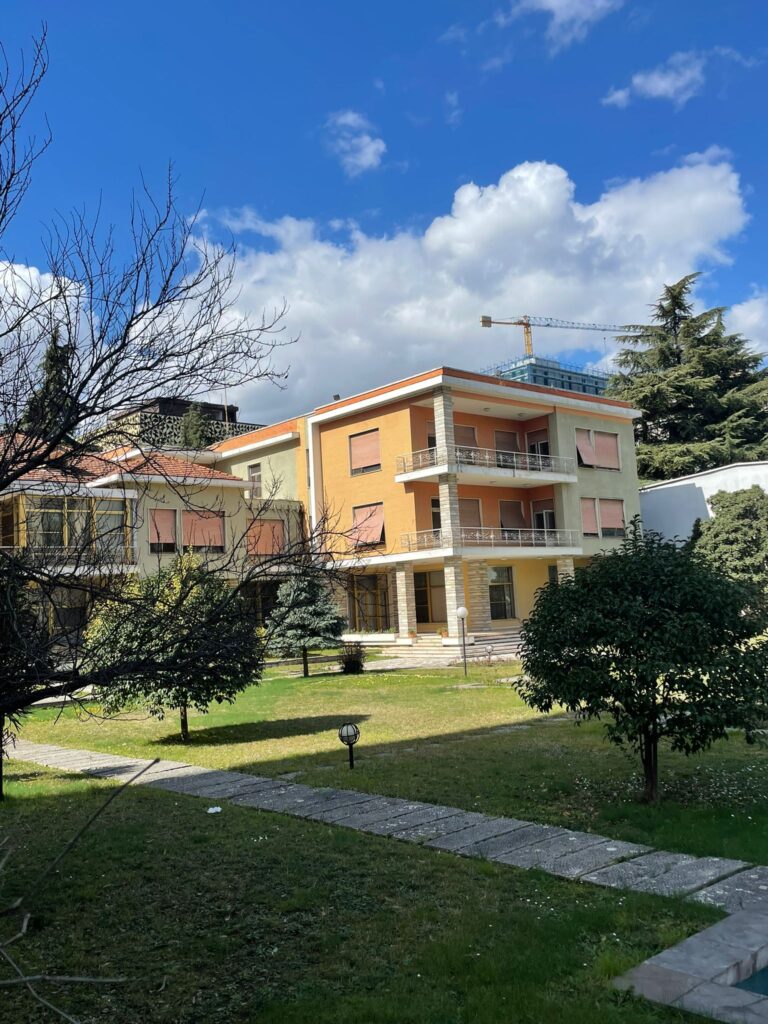
Ironically, opposite the communist dictator’s residence, is one of the most prominent faces of capitalism.
A KFC stands across the road with Colonel Sanders staring directly into Hoxha’s house.
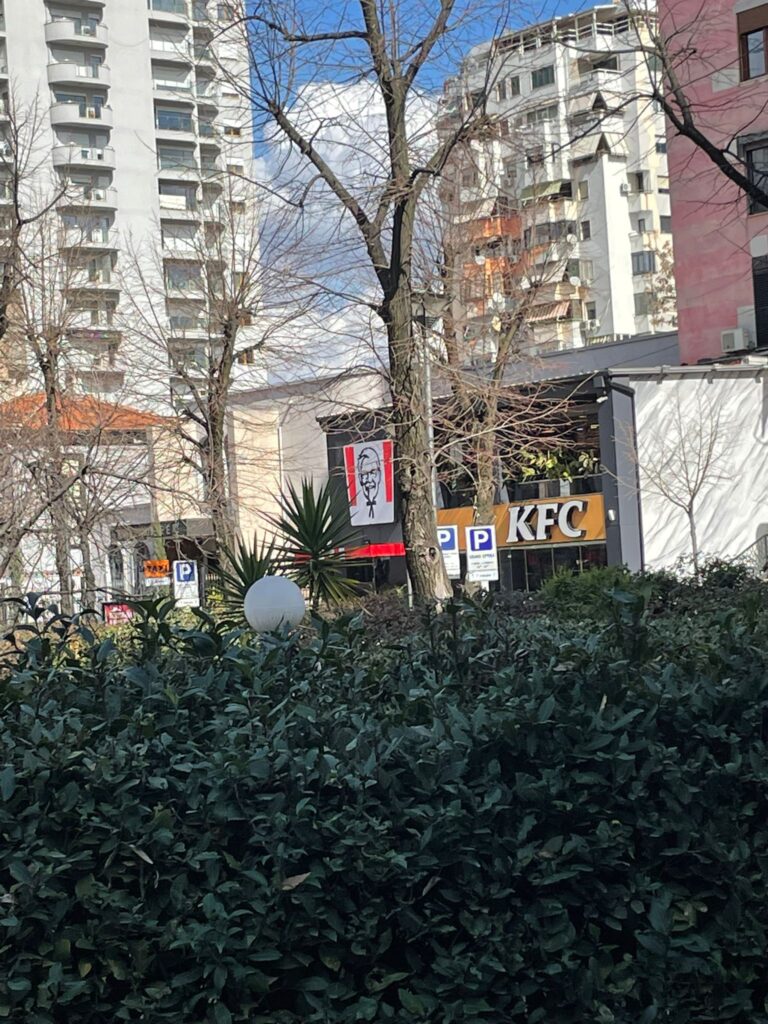
You cannot however go inside the property. The government has been debating for years what they should do with it. On one hand, they don’t wish to destroy such an important historical building. On the other, they don’t want to turn it into a shrine either.
Religious Buildings in Tirana
Albania is a Muslim country. Yet, just like Bosnia Herzegovina, it is a very liberal Muslim country. Pork and alcohol are common, with only a tiny percentage of the population having ever been to a mosque. There are a few mosques in Tirana, however the biggest is still under construction. Namazgah Mosque is set to be the biggest in the Balkans upon completion. No completion date has yet been set.
Perhaps the most impressive current religious building is the Resurrection of Christ Orthodox Church. One of the biggest orthodox churches in the Balkans. It stands opposite the House of Leaves Museum, which details Albania’s history in a building which once housed the Albanian secret police. It’s worth checking out if you’re unfamiliar with Orthodox architecture. Although there are better churches in the likes of Tallinn in Estonia for example.


Bunk’Art and Bunk’Art 2
Some of Hoxha’s infamous bunkers still remain in Tirana. And one has been converted into a large underground museum. Bunk’Art 2 displays and details Albania’s communist history in a series of tunnels built to withstand nuclear attacks. Hoxha and his allies set up offices and ministries in case of emergencies. They never used the bunker for this purpose in the end, but it’s interesting to see how the paranoid dictator was prepared.
Bunk’Art is located on the outskirts of Tirana. This is a bigger museum full of art and Cold War history. It takes a little longer to get here, over an hour if walking from Bunk’Art 2.
Tirana is certainly worth visiting in Albania for a minimum of 2-3 days.
Shkoder
Arrival in Shkoder
Take a bus from Tirana towards the Montenegro border, and in under two hours you will arrive in the small city of Shkoder.
Arrive at the bus station and your first impressions may be a little underwhelming. But it’s okay. Shkoder gets better as you walk towards the centre.
Once you arrive, you’ll come across a quaint little setting with a number of small cafes and restaurants lined along the street. You won’t find global brands down here.
Colonel Sanders is yet to arrive, and Starbucks is nowhere to be seen.
This does at least help Shkoder retain its charm. And meals in the local restaurants aren’t going to break the bank. It all makes a nice little spot to enjoy your food and drink whilst watching the world go by.
Rozafa Castle
Shkoder’s highlight is undoubtedly Rozafa Castle. This fortification was built around 3,000 years ago to keep Shkoder from attack.
As legend goes, a woman was once buried alive within the walls of the castle with no way to escape.
The woman requested that holes were built into the walls so she could retain contact with her young son. She believed that by accepting this fate, her son would grow up to become a great hero.
She was buried to prevent the walls of the castle falling down, according to a wise old man who approached the three brothers building the castle.
Her name was Rozafa and the castle was named in her honour.
Today the castle can be explored with some great views of Shkodra Lake below. At least on a clear day.
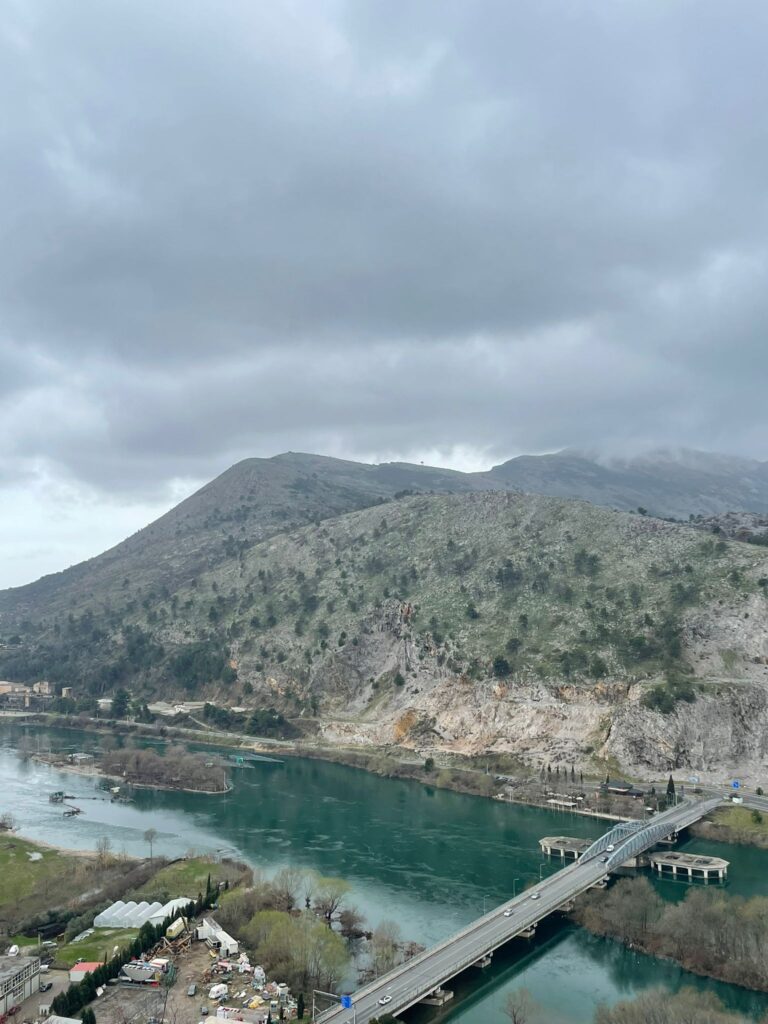
I enjoyed visiting this castle for a couple of hours. It doesn’t really take long to see everything, but it’s interesting to observe both the history and the life of people nearby.
Some young Albanian kids on a school trip encouraged me to say some (presumably rude) words in Albanian. Whilst goat herders walked past the outskirts of the castle with their livestock. It’s a different sort of vibe to Italy or France for example.
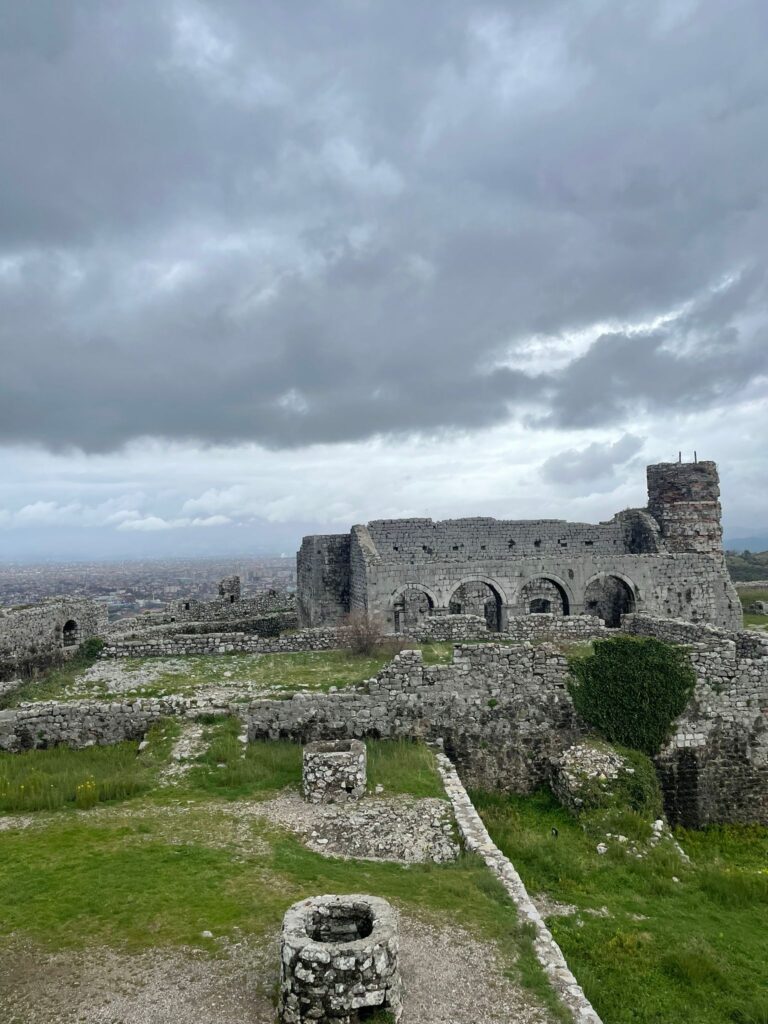
Football in Shkoder
As a football fan with a goal of watching a top level game in every country, I had to take in some football here. Unfortunately I missed out on a big derby in Tirana a few days previously, with tickets sold out and none available to buy on the day. However Shkoder-based Vllaznia were playing whilst I was in the city.
I went to a game, getting a ticket for just £1.55 ($2). As with many games involving small teams in Eastern Europe, it wasn’t well attended, but had a passionate following of around 100 ultras making noise which reverberated across the whole stadium.
The ultras didn’t like to be on camera however. I was enjoying their displays and took some pictures, only for a guy to talk to me in Albanian. I couldn’t understand what he was saying or what he wanted.
A few minutes later another guy came over, this time speaking English, and said I could not film the crowd (which included a guy wearing a full balaclava over his face).
I happily put my phone away after that. Certainly not going to mess with Albanian ultras.
Anyway, the game finished 1-1 without further incident. It was a pleasant experience but I wouldn’t say it’s worth going out of your way for unless you’re a fellow diehard football fan.
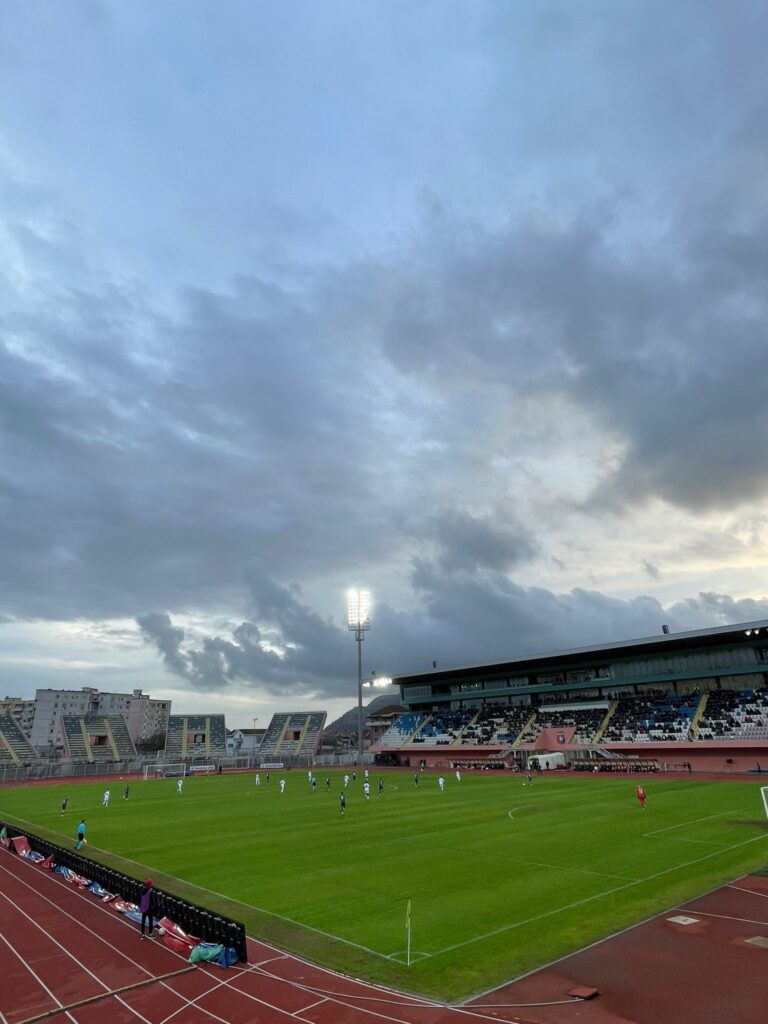
Other Places Worth Visiting in Albania
If you’re still asking the question, “is Albania worth visiting?” then there are many other options beyond the two I’ve visited above. As mentioned previously, I avoided visiting the Albanian Riviera. It wasn’t quite beach weather when I went, and personally I’m not a massive beach lover anyway.
Ksamil is popular for beaches reminiscent of those in Thailand or the Philippines. Gjirokastra is famous for its Ottoman history and bazaar. Although it was also the birthplace of Enver Hoxha. Butrint is well known for Ancient Greek and Roman ruins. Whilst Vlore is a coastal resort, said to become packed in the summer.
Where to Stay in Albania
I will only ever recommend accommodation I have actually stayed in. Therefore the following options may or may not be suitable for you. These short reviews are based on authentic experiences rather than a Google search on “top ten budget/mid-tier/luxury hotels in Tirana.”
I generally stay in hostels, and will talk mostly about hostels when this is the case, as it was in Albania.
Tirana – Blue Door Hostel (£12/$15 Per Night)
Located just 15-minutes from Skanderbeg Square, this highly-rated hostel is run by volunteers. This does mean that the staff change on a regular basis and you come across a variety of different characters.
In fact, one of the volunteers when I stayed was a Canadian guy who seemed nice to begin with…
However it turned out he was quite good at chess. And boy, would he let you know about it. Fast-forward a couple of days and I probably bumped into the world’s most arrogant man. He would generally beat you, then let you know how great he is. Then proceed to keep bragging for a good 15 minutes after each game…
Ladies, I’m really sorry to disappoint, but I don’t know if this absolute charmer is still around. Probably not given the 8 months that have passed since staying here.
Anyone, is it worth staying here whilst visiting Albania? Let’s have a look at the pros and cons now.
Pros
Very affordable, and the hostel was kept clean. The bathrooms offer warm showers which is certainly a plus point in the winter. There are lights and charging sockets by the beds. Always a sign of luxury in a hostel. The wifi worked well and lockers were spacious. It was also easy to meet fellow travellers here.
Cons
Aside from the Canadian, the main con was the lack of a breakfast option. Although as of November 2023, it seems there is now breakfast included with all rooms, and the option to purchase dinner for an additional £5 ($6).
Overall
A good place to stay. This hostel has seemingly been created by someone with experience of staying in hostels elsewhere. Would say I liked my time here, rather than loved it. But I don’t have any major criticisms of the place. Perhaps the 8.9 rating on Booking at the time of writing is a little high, but 8 would seem reasonable.
Shkoder – Kultura Hostel (£11/$14 Per Night)
Whilst visiting Albania’s culture capital, I stayed in the suitably-named Kultura Hostel for two nights.
Was it worth it? Read on to find out.
Pros
It was well-located just a couple of minutes from the centre. It’s affordable, and they offer a nice coffee and croissant for breakfast. When I stayed, I was in a dorm room but no one else was put in the same room, therefore it was effectively a private room whilst I was there (they gave me the key so no one else could come in).
Cons
The wifi was patchy and it’s a bit gloomy inside. It’s located on top of a pub ran by the same people. The pub can get very noisy at night. I was there on a Friday and heard drunks running around all night. The staff in the pub don’t really come to the hostel part of the building unless checking people in. Therefore guests can get away with being rowdy and disrupting others.
Overall
It wasn’t really a bad place to stay. Although I wouldn’t want to spend more than a few days there. There certainly isn’t a hostel feel to the place. It feels more like a dungeon than a place you might want to stay. But the breakfast was at least nice and the privacy I had boosted this place in my estimations. Although perhaps I just got lucky, and you may be put with rowdy travellers.
I wouldn’t put this place in the “one to avoid” list. Although I’d also stop short of recommending it as a must-stay.
Is Albania Worth Visiting? Final Thoughts
Well, is Albania worth visiting?
Yes it is.
For both history fans and beach lovers it has a lot to offer, and given how cheap it is, why not give Albania a go?
Travelling is about discovering new and exciting places. Currently, Albania appeals more to the backpacker spending three months in Europe, than the tourist taking a week off work to go on holiday.
And Albania deserves more than that. There’s no reason why this country can’t attract a wider audience when it has so much potential. It has a very unique history, given how isolated it was for several decades. It offers a combination of medieval European history and dreamy beaches. In other words, the highlights of other European countries that receive far more attention from tourists.
Albania is absolutely worth visiting if you fancy trying something a little different.
Thanks for reading this far. If you’re interested in checking out other posts from my adventure to every country in the world, please check out my blog contents page.
